Woodswallows, Butcherbirds, Ioras and Cuckooshrikes
The gallery features images of Woodswallows, Butcherbirds and Allies from the Artamidae, see Taxonomy note below. Habitat includes Australia’s forests, gardens, and urban areas. Ioras (Aegithinidae), and Indomalaya species prefer wooded area habitats. Cuckooshrikes (Campephagidae) inhabit most forested environments. I photographed them in Australia and Singapore’s parks and reserves.
Woodswallows, Butcherbirds, Ioras and Cuckooshrikes
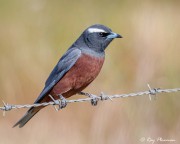
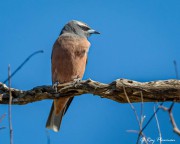
![Black Butcherbird (Melloria quoyi [Cracticus quoyi] rufescens) in the forest near Lake Eacham Queensland's wet tropics Black Butcherbird (Melloria quoyi [Cracticus quoyi] rufescens) in the forest near Lake Eacham Queensland's wet tropics](https://rayplowman.co.uk/wp-content/uploads/2018/11/Black-Butcherbird-0558-560x700.jpg)
![Black Butcherbird (Melloria quoyi [Cracticus quoyi] rufescens) Immature at Mason Creek, Cape Tribulation in Queensland wet tropics Black Butcherbird (Melloria quoyi [Cracticus quoyi] rufescens) Immature at Mason Creek, Cape Tribulation in Queensland wet tropics](https://rayplowman.co.uk/wp-content/uploads/2018/11/Black-Butcherbird-Immature-7600-180x144.jpg)
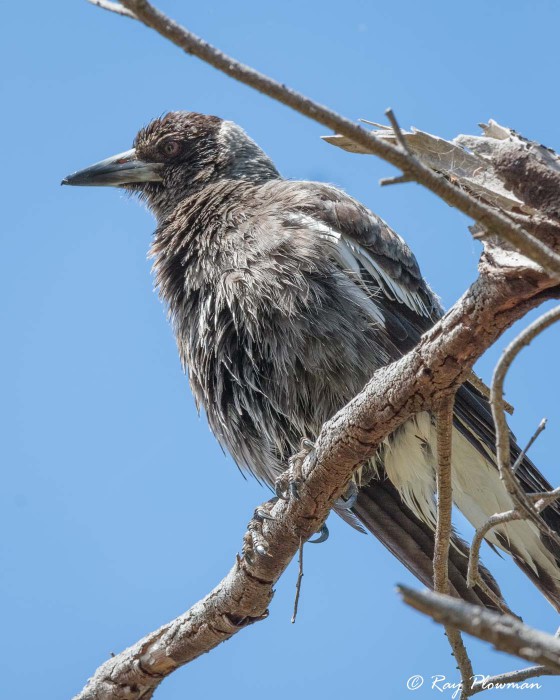
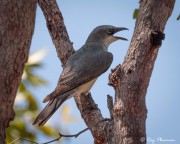
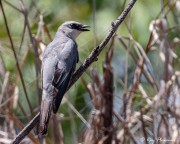
Woodswallow, Butcherbird, Iora and Cuckooshrike Notes
Images of showcased species are ‘Red List 2019’ assessed as ‘Least Concern’. Featured photos include five species of butcherbirds four of which are Australian endemics: Grey and Pied Butcherbird, Black and Pied Currawong together with an endemic White-browed Woodswallow. Also shown are adult portraits of five species from two genera of cuckooshrikes together with an image featuring Pied Triller chicks together with male and female photos of the Common Iora. The butcherbird subfamily also includes two subspecies of the Australian Magpie, Black-backed and White-backed forms displayed in the galley below.
.
Australian Black-backed and White-backed Magpies
![Australian Magpie [Black-backed] (Gymnorhina tibicen terraereginae) male on the ground at Flinders Ranges Australian Magpie [Black-backed] (Gymnorhina tibicen terraereginae) male on the ground at Flinders Ranges](https://rayplowman.co.uk/wp-content/uploads/cache/2020/05/Australian-Magpie-Black-backed-Male-_D4_7176d/230238244.jpg)
![Australian Magpie [Black-backed] (Gymnorhina tibicen terraereginae) female at Hervey Bay Botanic Gardens Australian Magpie [Black-backed] (Gymnorhina tibicen terraereginae) female at Hervey Bay Botanic Gardens](https://rayplowman.co.uk/wp-content/uploads/cache/2020/05/Australian-Magpie-Black-backed-Female-_7D_0158d/425305072.jpg)
![Australian Magpie [Black-backed] (Gymnorhina tibicen terraereginae) male foraging for grubs in the grass at Hervey Bay Botanic Gardens Australian Magpie [Black-backed] (Gymnorhina tibicen terraereginae) male foraging for grubs in the grass at Hervey Bay Botanic Gardens](https://rayplowman.co.uk/wp-content/uploads/cache/2020/05/Australian-Magpie-Black-backed-Male-_7D_0156d/2857401394.jpg)
![Australian Magpie [Black-backed] (Gymnorhina tibicen) male foraging for insects in the grass at Eagleby Wetlands Australian Magpie [Black-backed] (Gymnorhina tibicen) male foraging for insects in the grass at Eagleby Wetlands](https://rayplowman.co.uk/wp-content/uploads/cache/2020/05/Australian-Magpie-Black-backed-Male-_7D_0322d/2667278088.jpg)
![Australian Magpie [White-backed] (Gymnorhina tibicen telonocua) male perched on a rock at Bel Air National Park Australian Magpie [White-backed] (Gymnorhina tibicen telonocua) male perched on a rock at Bel Air National Park](https://rayplowman.co.uk/wp-content/uploads/cache/2020/05/Australian-Magpie-White-backed-Male-_D4_1689d/2091902594.jpg)
Australian Magpie Notes
The gallery includes a selection of male, female, immature and behavioural images of several Australian Magpie (Gymnorhina tibicen) subspecies from two colour forms: (a) Black-backed Magpies: G. t. tibicen (nominate) and G. t. terraereginae, (b) White-backed Magpies G. t. tyrannica and G. t. telonocua.
I’ve identified these four subspecies firstly by location and secondly by plumage indicators, such as trouser colour. Hybridisation between black-backed and white-backed magpies occurs where their ranges meet. Hybrid birds have two white zones, separated by black, on their backs. None of the featured birds appears to be hybrids.
Pied Triller Nesting Behaviour
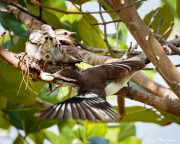
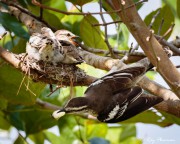
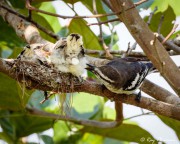
Pied Triller Nesting Behaviour Notes
The female chose to build its nest in Kranji Marshes car park, as such it attracted lots of photographers. This short photo essay shows images of the female bringing insects back to the nest to feed her chicks, removal of faecal sacs and the chicks squawking for more food. The young were ready to fledge and just fitted in the shallow nest. The on the right seemed to get most of the food.
Butcherbirds Behaviour

![[Australian] Black Butcherbird (Melloria quoyi rufescens) feeding on spiders at Mission Beach in Queensland's wet tropics [Australian] Black Butcherbird (Melloria quoyi rufescens) feeding on spiders at Mission Beach in Queensland's wet tropics](https://rayplowman.co.uk/wp-content/uploads/2018/11/Black-Butcherbird-8652-560x700.jpg)
![[Australian] Black Butcherbird (Melloria quoyi rufescens) feeding at forest edge, Lake Eacham in Queensland's wet tropics [Australian] Black Butcherbird (Melloria quoyi rufescens) feeding at forest edge, Lake Eacham in Queensland's wet tropics](https://rayplowman.co.uk/wp-content/uploads/2018/11/Black-Butcherbird-Immature-0555-180x144.jpg)
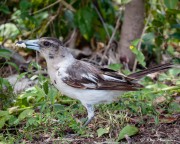
Butcherbirds and their Allies Behaviour Notes
The first three images show a Pied Currawong feeding on a flying fox (bat) in one of Sydney’s Royal Botanic Garden’s trees. I assume this was carrion left by a predator of the flying fox. There is no longer any grey-headed flying-fox colonies in the garden, so I guess they still visit from other camps around Sydney. Other images feature several species of butcherbird foraging for food; including an immature Pied Butcherbird trying to extract a grub from a hole in the tree branch. A Grey-head Butcherbird had bathed in the Tidal River at Wilsons Promontory and was drying out and preening itself. The final image shows a Black Currawong perched on my car wing-mirror at Cradle Mountain.
Woodswallows, Butcherbirds and Allies Taxonomy
Malaconotoidea placed in suborder Passeri, parvorder Corvida, similarly for Campephagidae. J Boyd Taxonomy in Flux Checklist includes nine Malaconotoidea families and one family in Campephagidae. For clarity, the family tree only includes the two Malaconotoidea families.
I’ve combined Malaconotoidea and Campephagoidea into one photo album, which includes the following families:
(a) Woodswallows and Butcherbirds (Artamidae) which comprises two subfamilies: Woodswallows (Artaminae) and Butcherbirds and allies (Cracticinae),
(b) Ioras (Aegithinidae),
(c) Cuckooshrikes (Campephagidae)
Butcherbirds and Allies (Cracticidae) merged with Woodswallows (Artamidae).
Some authorities lump all the above families in superfamily Corvoidea.












![Australian Magpie [Black-backed] (Gymnorhina tibicen) female perched at Wall Reserve in North Haven Australian Magpie [Black-backed] (Gymnorhina tibicen) female perched at Wall Reserve in North Haven](https://rayplowman.co.uk/wp-content/uploads/cache/2020/05/Australian-Magpie-Black-backed-Female-_7D_0594d/1350715298.jpg)
![Australian Magpie [White-backed] (Gymnorhina tibicen telonocua) female perched on a rock at Bel Air National Park Australian Magpie [White-backed] (Gymnorhina tibicen telonocua) female perched on a rock at Bel Air National Park](https://rayplowman.co.uk/wp-content/uploads/cache/2020/05/Australian-Magpie-White-backed-Female-_D4_1719d/1432904528.jpg)
![Australian Magpie [White-backed] (Gymnorhina tibicen tyrannica) male in the grass at SA Bool Lagoon in South Australia Australian Magpie [White-backed] (Gymnorhina tibicen tyrannica) male in the grass at SA Bool Lagoon in South Australia](https://rayplowman.co.uk/wp-content/uploads/cache/2020/05/Australian-Magpie-White-backed-Male-_D4_9864d/346328080.jpg)
















